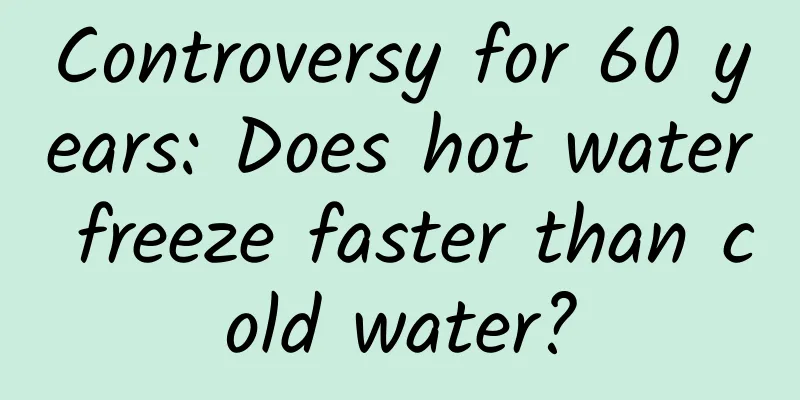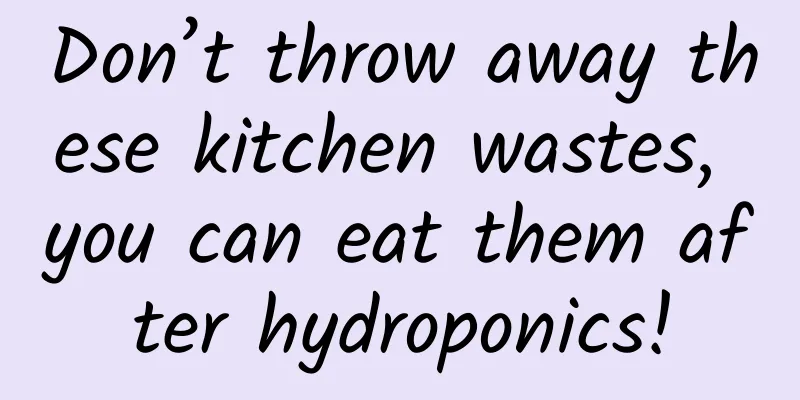Controversy for 60 years: Does hot water freeze faster than cold water?

|
For a long time, there has been a saying that hot water freezes faster than cold water, and many people have even confirmed this conclusion through life experience and experiments. This phenomenon is called the Mpemba effect, which originated from a Tanzanian middle school student named Mpemba who rediscovered the phenomenon in 1963. The earliest recorded observation of this effect can be traced back to the time of Aristotle. However, the basic Mpemba effect violates the first law of thermodynamics, so what is the reason for people to observe this magical phenomenon? It has been 60 years since the systematic study of this phenomenon began, and there is still no perfect answer. By Martin Bier (Professor of Physics, East Carolina University) Translation| 1/137 Erasto Mpemba, 13, was in high school when he observed that if a mixture of milk and sugar was placed in the refrigerator while hot, it solidified faster. This happened in Tanzania in 1963. As Mpemba continued to research his findings, his physics teacher told him it was nonsense. On the other hand, a local street ice cream vendor was all too familiar with Mpemba's observations. A few years later, the famous British physics professor and diplomat Denis Osborne visited Mpemba's school and gave a lecture. During the question-and-answer session after the lecture, young Mpemba mentioned his discovery again, but was still ridiculed by his teacher and classmates. Yet the distinguished diplomat became intrigued and, on his return to Dar es Salam, he experimented with water instead of ice cream. Eventually, the duo published their article in the journal Physics Education in 1969 (Mpemba and Osborne, 1969). Mpemba was finally proven right! The article, co-authored by Mpemba and Osborne, is an extremely readable and has become a classic. A graph from Mpemba and Osborne’s 1969 Physics Education paper providing evidence that hot water freezes faster than cold water. Image credit: Mpemba, EB, and DG Osborne. 1969. Cool? Physics Education 4: 172–75. Today, the phenomenon that hot water freezes faster than cold water is known as the Mpemba Effect. However, the history of this idea goes back much further than the 1960s. In the fourth century BC, Aristotle wrote in his work on meteorology that if water is heated beforehand, this helps the freezing process: because it cools more quickly (Aristotle 1952). In the early 17th century, Francis Bacon first articulated the method of gaining scientific knowledge and insight through observation and reasoning. In his Novum Organum, he wrote that “water slightly heated freezes more readily than water completely cooled” (Bacon 1902). None of this history is mentioned in Mpemba and Osborne’s article on physical education. After stating the Mpemba effect, Aristotle used it to explain the fact that heavy rains often come in torrential rains in hot climates: "For the same reason, in Arabia and Aethiopia, the rains fall in summer rather than in winter, and many times a day, and with great force: the clouds are quickly cooled by the reaction of the heat, which is very great" (Aristotle, 1952). This is a false explanation of a real phenomenon. | Image credit: Jessie Eastland, Wikimedia Commons. Mpemba and Osborne’s article details how young, naive Mpemba was misunderstood and ridiculed when he recounted his findings, and that no teacher took him seriously. This naturally draws sympathy from the reader for Mpemba. The story depicts a passionate and upright young man clashing with the narrow-minded “establishment.” It is also reminiscent of the struggles of Galileo and Einstein, both groundbreaking scientists who fought against a dogmatic ruling order. Osborne’s experiments, and the articles reporting their results, are the heartwarming happy endings of Hollywood movies—the Cinderella story of 20th-century academia. Erasto Mpemba (Photo: PA Images / Alamy Stock Photo) The Mpemba Effect and Its Basic Principles In fact, the Mpemba and Osborne article was wrong in many ways. The ridicule Mpemba experienced was based on scientific intuition. The Mpemba effect challenges the insights and understanding that physics researchers have gained over the years. In the 19th century, physicists gradually realized that heat is a form of energy. When a gallon of water is cooled from its boiling point (100°C) to its freezing point (0°C), energy is released. This process is reversible, meaning that the same amount of energy must be added back to return the water from freezing to boiling. If the Mpemba effect were real, it would mean that it would take more energy to heat water from freezing to 80°C than to 100°C. This contradicts the fact that if you heat a cup of water in a microwave for longer, it will reach a higher temperature. The Mpemba effect violates the first law of thermodynamics, which states that energy can neither be created nor destroyed, but can only be transferred from one form to another. The first law of thermodynamics is probably the most well-documented law in physics and can be considered a universal principle. By violating this law, the Mpemba effect means it is possible to create a perpetuum mobile. Let's get even more crazy. Suppose we have two glasses of room temperature water, the first has been at room temperature for a long time, and the second has just cooled down from a higher temperature. We put both glasses in the freezer. According to Aristotle, Bacon, and Mpemba, the second glass will freeze faster than the first, which means that the glasses somehow "remember" what happened in the past (i.e., whether they were previously heated). This is completely inconsistent with our understanding of thermodynamics! In liquid water at room temperature, each molecule moves at a speed of about 400 meters per second (editor's note: the original unit is miles per second), and on average, there are about a trillion collisions per second. This is called Brownian motion (editor's note: this is not rigorous). Temperature is just a number that indicates the average energy of the Brownian motion of the molecules. Brownian motion makes it impossible for the molecules in a glass of water to maintain a certain structure; there is no mechanism to preserve "memory". Mpemba’s description of different freezing rates contradicts basic thermodynamic principles. In 1963, and still today, physics teachers have a professional obligation to point this out and explain why. The Mpemba effect has been a surprising and controversial topic for decades, largely because physicists have misinterpreted poorly designed experiments. Brownridge's Experiment The decisive result came in 2011 when James Brownridge of Binghamton, State University of New York, published an article in the prestigious American Journal of Physics (Brownridge, 2011). Brownridge’s work was meticulous and detailed. The apparatus Brownridge used to study the Mpemba effect. By eliminating variables that might be beyond the experimenter's control, Brownridge attempted to produce reliable, reproducible results. Image by the author based on Figure 2 of Brownridge's paper. Heat flows from a hot object to a cold object. There are three ways to transfer heat: (1) Heat conduction occurs inside solid materials where the molecules are fixed in position; this is why a teaspoon in hot tea becomes hot. (2) Convection occurs when gases or liquids circulate between hot and cold objects, transferring heat; this is how a convection oven works. (3) Thermal radiation is electromagnetic radiation emitted by all objects. The higher the temperature of an object, the more radiation it emits. For example, sunlight is the thermal radiation we receive from the sun. In order to properly test the Mpemba effect experimentally, these three forms of heat transfer need to be controlled as much as possible in the experiment. The diagram above shows Brownridge's experimental setup. Distilled water is contained in a fused-sealed vial, suspended by a wire in a vacuum created by a copper box. Copper is a good conductor of heat, which ensures that the temperature around the bottle is equal everywhere. The temperature of the bottle is measured continuously and accurately by an electronic device called a thermocouple. Note that thermal radiation is the only way for the bottle to exchange heat with the copper box. Due to the vacuum, conduction and convection have been eliminated. Heat transfer through the wire can be ignored. Even in Brownridge's experimental setup, however, we cannot completely control everything. The freezing process always starts from a nucleation point and spreads outward. The nucleation site is usually a dust-sized particle; for tap or pond water, it is usually a large number of dust particles or other impurities. The water then freezes rapidly at 0°C. But in Brownridge's experiment, pure distilled water may remain liquid even below 0°C, a phenomenon known as "supercooling." In fact, pure water can remain liquid all the way down to -45°C. The distilled water in Brownridge's experiment tends to freeze between -20°C and 0°C. The freezing temperature varies from bottle to bottle, but is always the same for a particular bottle. This is probably because the nucleation sites in Brownridge's vials are tiny irregularities in the glass walls of the container. Brownridge discovered that, for vials of the same shape and size, the one with the lower temperature always reached 0°C first. In principle, it is possible that the vial with the warmer water freezes before the vial with the cooler water. This results in a higher freezing temperature when there are tiny irregularities in the glass wall of the warmer vial. It turns out that the wall irregularities are the cause of this phenomenon, which can be verified by the fact that the freezing temperature is always the same for the same vial. Details and Reproduction When conducting scientific experiments, it is important to consider all the variables and how they might affect the results. Spontaneous generation—another idea from Aristotle—is a good example. Until the late 17th century, people believed that flies originated from decaying corpses, shells spontaneously formed from sand, and mice emerged from grains. Simple experiments, isolating and observing corpses, sand, and grains, proved these beliefs wrong. Ice cream vendors in Tanzania can confirm that Mpemba's observations are not surprising. The vendors probably use freezers without dehumidifiers. During the day, the freezers are opened and closed many times, and each time a certain amount of hot, humid air enters. Since cold air has a lower humidity than hot air, the excess moisture is deposited inside the freezer in the form of ice crystals, forming a layer of frost. Air is a good thermal insulator, and if you put a cup of water in a freezer, most of the cooling process will occur through the bottom of the cup where it touches the freezer. However, if the cup is placed on a layer of frost, the cooling process will be slower. This is because frost is porous and contains a lot of air. The frost layer is actually like a cashmere sweater between the cup and the cold surface. But now imagine placing a hot cup on a thin layer of frost. The frost layer may melt, and the cup will eventually completely touch the bottom of the freezer. It may then cool faster than the cup that started at a lower temperature, thus winning the ice-making race. The claim that warm water freezes faster than cold water is too general to be considered scientific. Lake Michigan will not freeze over on a freezing night, but a small container of hot water placed on the edge of Lake Michigan will freeze easily from top to bottom. So scale is a factor. The material that makes up the contact surface also plays a role. Water in a metal container will freeze faster than water in a wooden container of the same size and shape because metal conducts heat better than wood. The shape of the container is also important. Water on a tray will freeze faster than the same volume of water in a spherical container due to the larger contact surface. Scientific papers usually describe the experimental procedures and equipment used in detail in the Materials and Methods section. A good Materials and Methods section ensures that the experimental results are reproducible. The brief discussions by Aristotle and Bacon do not provide enough details for us to find out how the Mpemba effect was obtained. Aristotle then goes on to say: "Therefore, many people who want to cool water quickly first expose it to the sun" (Aristole, 1952). Bacon's assertion about the Mpemba effect is a side note in his obscure description of pharmacology (Bacon, 1902). In the decades following the 1969 publication of Mpemba and Osborne's article, many experiments on the Mpemba effect were performed. Sometimes the effect was observed, sometimes it was not. Different researchers used different experimental setups, and few attempted to fully reproduce the results of others. The many variables involved in the freezing of water, the lack of proper detail in the reports, and the lack of a serious emphasis on reproducibility ultimately caused the myth of the Mpemba effect to persist for much longer than it should have. In the decade since Brownridge’s paper, the way the Mpemba effect was described has changed. There are fewer articles proposing unusual mechanisms to explain it. In 2012, the Royal Society of Chemistry organized a competition with a prize of £1,000 to find the best explanation of the Mpemba effect. The Society received 22,000 entries, and Mpemba himself was present at the award ceremony. The winner was Nikola Bregović of the University of Zagreb. In his winning article, Bregović described his experiments and limited his analysis to basic thermodynamics (Bregović, 2012). He identified four factors that may be important: evaporation, dissolved gases, convection, and supercooling. Bregović considered supercooling to be the most important factor and quoted Brownridge's article in his conclusion: "Warmer water will freeze before colder water only if the colder water is supercooled, and this will only happen if the nucleation temperature of the colder water is several degrees lower than that of the hotter water. Heating the water may lower, raise, or not change the natural freezing temperature" (Bregović, 2012). In a lengthy article published in Scientific Reports in 2016, Henry Burridge and Paul Linden of Cambridge University provide a detailed review of the confusion and lack of reproducibility surrounding the topic since 1969. The authors conducted their own experiments and ruled out supercooling as a factor by measuring how long it takes water to cool to 0°C. The Mpemba effect doesn’t occur. The title of the article sums up the problem well: “Questioning the Mpemba Effect: Hot Water Does Not Cool More Quickly Than Cold” References 1. Aristotle. 1952. Meteorologica. Translated by HDP Lee. Loeb Classical Library 397. Cambridge, MA: Harvard University Press. Book 1, Chapter 12. Free translation also online at http://classics.mit.edu/Aristotle/meteorology.1.i.html. 2. Bacon, F. 1902. Novum Organum. Translated by J. Devey. New York: PF Collier & Son. Book 2, Chapter 50, Section 4, p. 277. Also online at https://www.thelatinlibrary.com/bacon/bacon.liber2.shtml. 3. Bregović, N. 2012. Mpemba effect from a viewpoint of an experimental physical chemist. Online at https://www.rsc.org/images/nikola-bregovic-entry_tcm18-225169.pdf. 4. Brownridge, JD 2011. When does hot water freeze faster than cold water? A search for the Mpemba effect. American Journal of Physics 79: 78–84. 5. Burridge, HC, and PF Linden. 2016. Questioning the Mpemba effect: Hot water does not cool more quickly than cold. Scientific Reports 6: 37665. 6. Mpemba, EB, and DG Osborne. 1969. Cool? Physics Education 4: 172–75. postscript This article was published in June 2023. The author quoted a sentence from the 2016 article by Burridge and Linden as a conclusion: "The title of the (Berridge and Linden) article summarizes the problem well: 'Questioning the Mpemba Effect: Hot Water Does Not Cool Faster Than Cold Water.'" It seems that the academic discussion on the Mpemba effect should have been settled by this point (2016). However, after Burridge and Linden's 2016 article, a considerable number of articles on the Mpemba effect still appear every year. Here are just a few (in chronological order) as a supplement to the main text: 1. Z. Lu and O. Raz, Nonequilibrium thermodynamics of the Markovian Mpemba effect and its inverse, PNAS 114, No. 20, 5083-5088 (2017). 2. M. Baity-Jesi, E. Calore, A. Cruz, and D. Yllanes, The Mpemba effect in spin glasses is a persistent memory effect, PNAS 116, No. 31, 15350-15355 (2019). 3. A. Kumar and J. Bechhoefer, Exponentially faster cooling in a colloidal system, Nature vol. 584, 64–68 (2020). 4. A. Kumar, R. Chétrite, and J. Bechhoefer, Anomalous heating in a colloidal system, PNAS 119 (5), e2118484119 (2022). 5. R. Holtzman and O. Raz, Landau theory for the Mpemba effect through phase transitions, Nature Communications Physics, vol. 5, 280 (2022). Therefore, the conclusion of the Mpemba effect seems to be still unresolved. For other popular science introductions to the effect, readers can refer to Quantum Magazine's 2022 popular science article: Does Hot Water Freeze Faster Than Cold? Physicists Keep Asking. | Quanta Magazine. For further relevant research details, please refer to the above-listed papers and the references cited therein. This article is translated from Martin Bier, “The Rise and Fall of the Mpemba Effect”, Skeptical Inquirere Volume 47, No. 4 Original link: Produced by: Science Popularization China 1. Go to the "Featured Column" at the bottom of the menu of the "Fanpu" WeChat public account to read a series of popular science articles on different topics. 2. Fanpu provides a function to search articles by month. Follow the official account and reply with the four-digit year + month, such as "1903", to get the article index for March 2019, and so on. |
<<: Your phone screen is broken? Don’t worry, “live” materials can save it!
>>: The importance of sleep: It turns out that sleeping well has so many benefits!
Recommend
Fudan University and Ant Group join forces to "beat" the human brain with the human brain
In 2003, a graduate student named Wang Xiaofei fr...
Why is WeChat far less profitable than Facebook?
An interesting data is that in the third quarter ...
The chat tool is here! Baidu Input Method 10.0 version is released
In order to improve everyone's input efficien...
Your complexion is like a color palette. Don’t ignore the health signals your body sends you!
In traditional Peking Opera, different characters...
How Internet vendors are changing the smart terminal market
Recently, Damai Technology announced its official...
Start from scratch to analyze user operation cases
What I want to share with you today is the user o...
3 templates for high-conversion promotion ideas!
How to write a stunning opening for your creative...
What are the functions of the Lanzhou Photography Mini Program? How much does it cost to create a professional photography app?
Everyone's exposure to photography is differen...
Hot! Decrypt the most complete APP operation and promotion strategy in history, a must-have manual for experts to grow
In 2015, mobile Internet startup products face mo...
Do you think that stomach pain will go away if you just endure it? Be careful! These types of stomach pain are particularly dangerous...
Expert of this article: Zhao Weitong, attending p...
Analysis of competitive products of Jianying APP
“ Competitive product analysis is one of the esse...
Marketing promotion: Luckin Coffee’s traffic pool thinking!
Luckin Coffee ’s new product, the Lucky Snacks, h...
Analysis of Hema fresh food products!
Since its establishment in 2016, Alibaba's He...
High-quality landing page optimization techniques for information flow!
This article brings you a guide to optimizing the...
Giant ships also have Iron Man's "armor"? The "secret weapon" in shipbuilding
Did you know that behind those giant ships that t...









